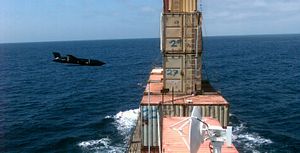The U.S. Air Force and U.S. defense contractor Lockheed Martin successfully tested a production configuration Long-Range Anti-Ship Missile (LRASM) from a B-1B Lancer long-range strategic bomber over Point Mugu Sea Range in California, the company announced in a March 19 statement.
“During the test, a B-1B from the 337th Test Squadron at Dyess Air Force Base, Texas, launched a LRASM over the Sea Range at Point Mugu, Calif., successfully impacting the maritime target and meeting test objectives,” the statement reads.
It was the sixth consecutive successful test of the LRASM announced by the defense contractor. “LRASM has now proven itself in six consecutive flight missions,” said David Helsel, LRASM program director at Lockheed Martin Missiles and Fire Control. “The reliability and outstanding capability of LRASM will provide an unmatched weapon to our warfighters in their quest for sea control in contested environments.”
LRASM, a next-generation anti-ship missile with standoff capabilities, designed to detect and destroy specific targets within groups of surface warships in electronic warfare environments, was last test fired in December 15 that involved the test of two missiles fired from two B-1Bs.
The missile’s design is a derivative of the Joint Air-to-Surface Standoff Missile – Extended Range (JASSM-ER), a long-range cruise missile with an estimated range of up 1,000 kilometers (620 miles). As I explained in August 2017:
The LRASM began as a joint research project by the Defense Advanced Research Projects Agency (DARPA) and the U.S. Navy in 2009. The aim of the LRASM project was to deliver a new generation of anti-ship missiles with standoff capabilities — in other words, missiles with extended range, which would enable ships and aircraft to launch the weapon without being exposed to enemy counter fire. According to Lockheed Martin, the subsonic LRASM has an estimated range of over 320 kilometers and is fitted with a 450-kilogram penetrator and blast fragmentation warhead.
Furthermore, I noted in December 2017:
Lockheed Martin was officially awarded a contract for the production of 23 air-launched LRASM, officially designated AGM-158C, in July 2017. The LRASM will be integrated on the U.S. Air Force fleet of B-1B Lancers and F/A-18E/F Super Hornets. “The air-launched variant provides an early operational capability for the U.S. Navy’s offensive anti-surface warfare Increment I requirement to be integrated onboard the U.S. Air Force’s B-1B in 2018 and on the U.S. Navy’s F/A-18E/F in 2019,” according to a Lockheed Martin statement.
Admiral Harry B. Harris, Jr., Commander of U.S. Pacific Command in a 2016 testimony in front of the Senate Armed Services Committee said that the LRASM “is a great capability we need to bring on line fast.”
































